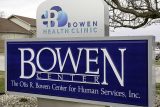Schenkel’s Dairy is now a Kemp’s Facility
General
 Posted by: Steve Kimmel 1 year ago
Posted by: Steve Kimmel 1 year ago
Alvin Schenkel and his family settled on a piece of land in Huntington, Indiana, in 1930 with the intention of running a local, family-run dairy. Now part of the Kemps® brand, the same piece of land is used to process millions of gallons of fluid milk yearly.
Purchased by Dairy Farmers of America within the last two years, the facility has continued to grow. However, the small red barn that the Schenkel’s milked, pasteurized and bottled milk out of to distribute to the community is still visible from a bird’s eye view.
“The plant was originally built in 1930, and it has been built around the original barn,” says Stephen Heinzmann, plant manager. “There are certain areas in the plant you can still walk through where they used to run the cattle down to be milked a long time ago.”
Much of the facility’s growth and adaptations are attributed to the increase in production over time. Most recently, the plant became a Kemps facility to align with regional branding. During this shift, the plant increased production from 46 million gallons a year to nearly 60 million providing milk for Aldi, Dollar General, Family Express, Jewel, Meijer, Starbucks and Target, to name a few.
“A few plants closing near the area left a large gap in the milk supply to Chicagoland,” Heinzmann says. “When the plants in Harvard, Illinois and De Pere, Wisconsin closed, there wasn’t a single facility in the area that could take on all that volume all at once.”
Making sure our family farm-owners’ milk has a place to go has always been a top priority for DFA. Stephen says a lot of adjustments were made to the Huntington plant to better equip the facility and seamlessly ensure that every drop of milk was accounted for.
“There used to be an observation hallway at the front where you could look into the plant. We cut a big section of that out to add an additional fluid filler so we could run additional gallons through here,” Heinzmann says. “We’re not utilizing it perfectly just yet, but we’re getting better every day. We are consistently seeing improvements to efficiencies on that machine, and that’s been a large enabler for us to achieve the success we now have.”
The process of getting the plant ready to take in the new milk was fast and furious – the team had about eight weeks to update the facilities before they increased its production. While the expansion and new equipment has helped the facility to meet market demands, to Heinzmann, the real heroes of this story are the plant employees.
“Employees here had to adjust to account for the increase in workflow,” Heinzmann says. “They’re the ones that are putting in the long hours and they deserve all the credit.”
While there were several learning curves along the way, Heinzmannn says one of the biggest takeaways was learning how to handle the scheduling – it needed to be better suited for the long hours and hard work needed to keep the milk flowing.
“Previously, employees worked five nine-hour days with a rotating day off and they were getting a weekend off every five to six weeks. With the increased volume, we had to go from a five-day production week to a six-day production week, sometimes extending into six and a half,” Heinzmann says. “Now they are working a four-day schedule, and it’s rotating, so every three weeks you’ll have a Friday through Tuesday off, which gives you a five-day weekend every three weeks. That’s helped to drive down overtime, and although we still have some ways to go there, we’re on the right path. This extra time off has boosted our employees’ morale.”
Many employees already see the shift to Kemps as a long-term opportunity to continue development, as new jobs have been created to match the additional production needs. Still, while the plant, schedules and management continue evolving to support the hardworking employees there, Heinzmann says he wants them to know that they can grow along with it – just as he has.
“Pretty much every position that there is here, I have done over the years,” Heinzmann says. “I’ve spent several years as an hourly employee and then moved into supervision and management. This is a Cooperative that provides opportunities to advance our careers and contribute to building a great life for you and your family. That’s what I try to tell my employees that this is not just a job – this is an opportunity for a career.”
You May Be Interested In:
Take Your Business to the Next Level
Call the Chamber and see how we can help you take your business to the next level. You can become an Ambassador, volunteer for our golf outing, attend one of our networking group meetings and more. Keep this site close by for all the happenings in Huntington County.



